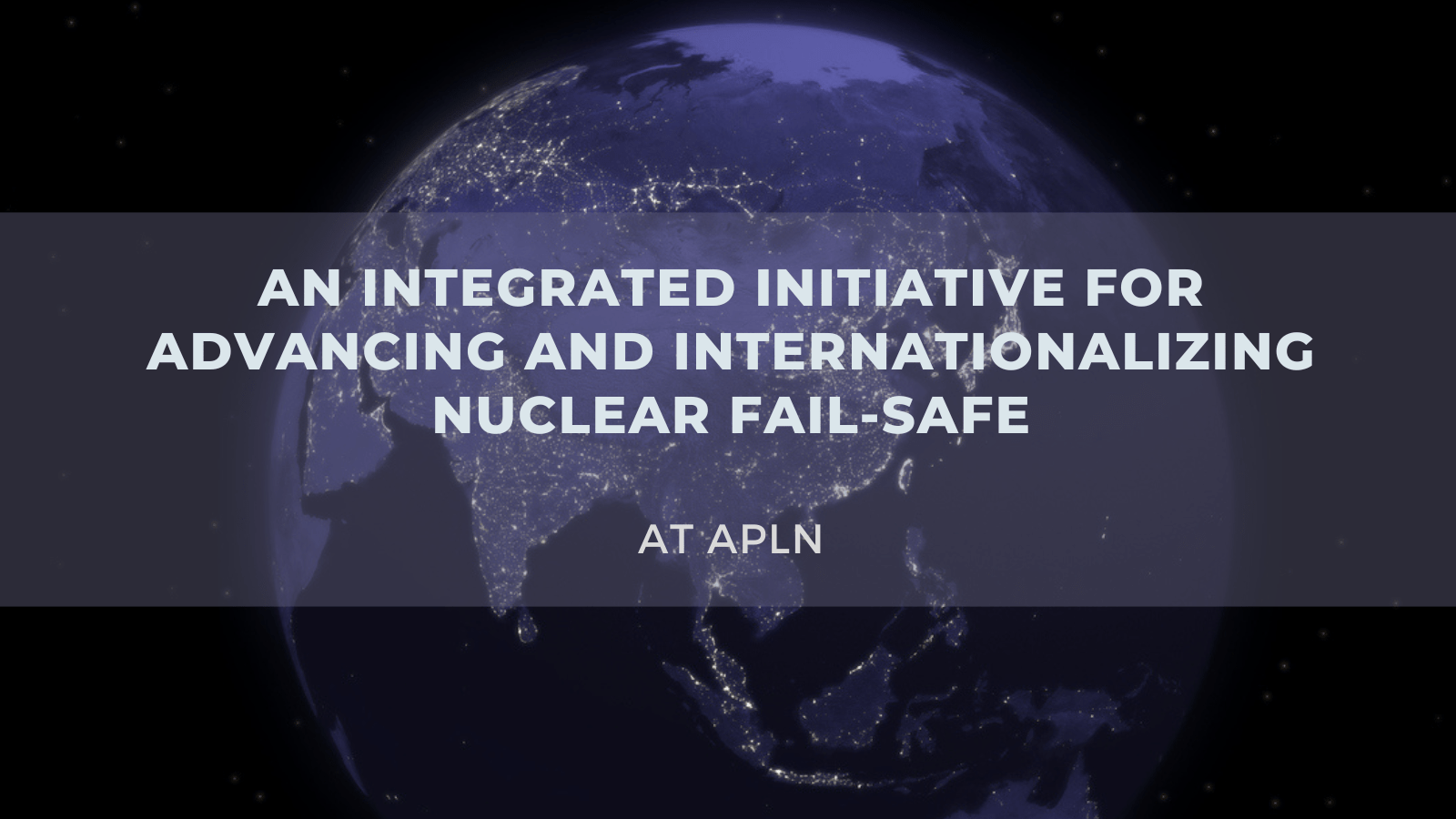Global Nuclear Fail-Safe: Meeting Summaries and Related Documents
The Nuclear Threat Initiative (NTI), Euro-Atlantic Security Leadership Group (EASLG), Asia-Pacific Leadership Network (APLN), and European Leadership Network (ELN) have worked since March 2020 to highlight the benefits of independent, internal “fail-safe” reviews in nuclear-armed states. Fail-safe reviews are aimed at strengthening safeguards to prevent unauthorized, inadvertent, or mistaken use of a nuclear weapon, including through false warning of an attack. These reviews would be effective unilateral nuclear risk-reduction steps, not requiring any negotiation, treaty, or verification.
The initiative to encourage independent nuclear fail-safe reviews globally derives from the U.S. 1992 Final Report of the Federal Advisory Committee on Nuclear Failsafe and Risk Reduction (initiated by Senator Sam Nunn and directed by Secretary of Defense Dick Cheney) and two NTI reports on cyber-nuclear threats, Nuclear Weapons in the New Cyber Age and U.S. Nuclear Modernization: Security & Policy Implications of Integrating Digital Technology.
NTI Co-Founder and Co-Chair Sam Nunn first proposed that nuclear-armed states conduct fail-safe reviews in remarks commemorating the 50th anniversary of the Nuclear Non-Proliferation Treaty in March 2020. Nunn and NTI Co-Chair and CEO Ernest J. Moniz underscored the proposal with co-authored essays published in Foreign Affairs in December 2020 and April 2023.
In December 2021, the 2022 National Defense Authorization Act mandated an independent fail-safe review of all U.S. nuclear systems. The law required the secretary of defense to charter an independent review of the safety, security, and reliability of nuclear weapons and related systems. This U.S. nuclear fail-safe review was concluded in 2024.
In February 2023, at the Munich Security Conference, the EASLG issued a statement on Advancing Global Nuclear Fail-Safe, calling on all nuclear-armed states to conduct their own internal fail-safe reviews. In May 2024, NTI provided support to APLN and ELN to encourage internal fail-safe reviews in their regions. Since then, APLN and ELN have hosted fail-safe workshops with non-governmental partners in China, India, Pakistan, France, and the United Kingdom to discuss nuclear fail-safe—producing agreed summaries of each of these meetings. NTI and the networks are continuing this work through 2025 and into 2026.
This work was made possible by a grant from the Peter G. Peterson Foundation. The statements made and views expressed are solely the responsibility of the authors.
Workshop summaries
- Read the APLN-China Meeting Summary
- Read the ELN-France Meeting Summary
- Read the APLN-India Meeting Summary
- Read the APLN-Pakistan Meeting Summary
- Read the ELN-United Kingdom Meeting Summary
- Read the paper on Chinese translations of “fail-safe” by Zhu Junwei, former director of the Center for American Studies, Grandview Institution; now Director, Horizon Insights Center
- Read the summary of the FARR’s final report
Related resources
Andreasen, Steven. 2024. “Avoiding Nuclear War Through Nuclear Failsafe.” Arms Control Association, September. https://www.armscontrol.org/act/2024-09/features/avoiding-nuclear-war-through-nuclear-failsafe.
Berghofer, Julia. 2025. “How To Strengthen Nuclear Failsafe.” The National Interest. https://nationalinterest.org/feature/how-strengthen-nuclear-failsafe.
Berghofer, Julia. 2025. “Guarding the unthinkable: Why regular fail-safe reviews are essential for responsible nuclear stewardship.” European Leadership Network. https://europeanleadershipnetwork.org/policy-brief/guarding-the-unthinkable-why-regular-fail-safe-reviews-are-essential-for-responsible-nuclear-stewardship/.
Bianco, Belen, and Rishi Paul. 2024. “Technological Complexity and Risk Reduction: A Guardrails and Self-Assessment Framework for EDTs in NC3 and Nuclear Weapons Decision-Making.” European Leadership Network. https://europeanleadershipnetwork.org/report/technological-complexity-and-risk-reduction-a-guardrails-and-self-assessment-framework-for-edts-in-nc3-and-nuclear-weapons-decision-making/.
Nuclear Threat Initiative. 2022. “Breaking Down the Cyber-Nuclear Threat.” YouTube. https://www.youtube.com/watch?v=A1R2ljrha4U.
Des Browne, Wolfgang Ischinger, Igor S. Ivanov, Ernest J. Moniz, and Sam Nunn. 2023. “Statement by the EASLG: Advancing Global Nuclear ‘Fail-Safe.’” Nuclear Threat Initiative. https://www.nti.org/analysis/articles/statement-by-the-easlg-advancing-global-nuclear-fail-safe/.
Junwei, Zhu. 2024. “Nuclear Fail-Safe: An Opportunity for the World.” China-US Focus, December 24. https://www.chinausfocus.com/peace-security/nuclear-fail-safe-an-opportunity-for-the-world.
Moniz, Ernest J., and Sam Nunn. 2021. “Biden Should Do More to Prevent the Accidental Launch of Nuclear Weapons. Here’s How.” The Washington Post, November 17. https://www.washingtonpost.com/opinions/2021/11/17/biden-should-do-more-prevent-accidental-launch-nuclear-weapons-heres-how/.
Moniz, Ernest J., and Sam Nunn. 2022. “NTI Statement on the 2022 Nuclear Posture Review.” Nuclear Threat Initiative. https://www.nti.org/news/nti-statement-on-the-2022-nuclear-posture-review/.
Moniz, Ernest J., and Sam Nunn. 2023. “Confronting the New Nuclear Peril.” Foreign Affairs, April 5. https://www.foreignaffairs.com/ukraine/russia-confronting-new-nuclear-peril.
Patil, Sameer, and Rahul Rawat. 2025. “Integration of Artificial Intelligence in Nuclear Systems and Escalation Risks.” Asia-Pacific Leadership Network. https://www.apln.network/analysis/policy-briefs/integration-of-artificial-intelligence-in-nuclear-systems-and-escalation-risks.
Nuclear Threat Initiative. 2025. “Statement by the EASLG: Three Essential Steps for Reversing the Slide to Nuclear War.”https://www.nti.org/analysis/articles/statement-by-the-easlg-three-essential-steps-for-reversing-the-slide-to-nuclear-war/.
Sultan, Adil. 2025. “Nuclear ‘Fail-Safe’ Reviews and Risk Reduction Approaches in South Asia.” Asia-Pacific Leadership Network. https://www.apln.network/analysis/commentaries/nuclear-fail-safe-reviews-and-risk-reduction-approaches-in-south-asia.
O’Donnell, Frank. 2025. “Existential Need for Reducing US-China Nuclear Tensions.” Asia-Pacific Leadership Network. https://www.apln.network/analysis/the-korea-times-column/existential-need-for-reducing-us-china-nuclear-tensions.
Downloads
Bell, Alexandra. 2024. “Remarks at NPT PrepCom Side Event on Technological Complexity and Nuclear Reduction: A Checklist and Guardrails Framework for EDTs in Nuclear Weapons Decision-making.” U.S. Department of State. Download here.
Stockholm Initiative for Nuclear Disarmament. 2025. “Navigating the Potential Impact of Emerging Technologies on Nuclear Disarmament, Arms Control, Non-Proliferation and Peaceful Uses of Nuclear Energy and Technology.” United Nations Digital Library. Download here.
U.S. Congress. 2022. “Sec. 1644. Review of Safety, Security, and Reliability of Nuclear Weapons Related System.” GovTrack.us. Download here.
U.S. Department of Defense. n.d. Final Report of the Federal Advisory Committee on Nuclear Failsafe and Risk Reduction. Download here.

